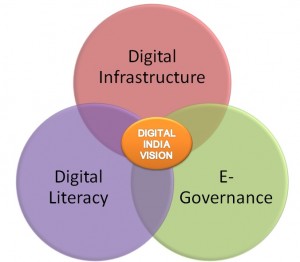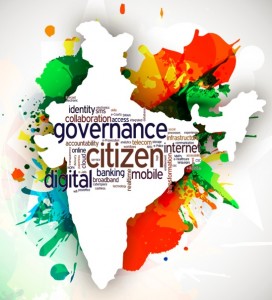Digital India Vision is an ambitious project of Prime Minister Narendra Modi. With an allocated budged over 1 Lakh crore, the project is aimed to bridge the gap between government services and citizens through digital transformation.
The project consists of three most important components:
Digital Literacy – India has third largest number of internet users in the world. With 35% of growth rate in number of users attained in 2014, India is expected to bypass United States and capture second lead position within this year. By the end of 2015, India is expected to have over 500 million internet users with the current growth rate.
E-Governance – It plays a crucial role in realizing Digital India Vision. Government is aiming to re-engineer the business processes using technology in order to increase collaborations between departments and integrate different platforms and services. . It aims at bringing in faster and transparent service delivery, accountability, information sharing and people participation in the decision making and govt. processes.
It brings in SMART Governance viz.:
S – Simple: Simplification of rules and procedures of Government making it user-friendly.
M-Moral: Infusing ethics and morals into officers through improvement of anti-corruption and vigilance agencies.
A– Accountable: ICT helps set standards of performance and efficiently measures it.
R– Responsive: Efficient service delivery and government that is in tune with the people.
T – Transparent: Information confined to secrecy is out in the public domain bringing equity and rule of law in public agencies.
According to the Press Information Bureau, Government of India’s release dated 20th August, 2014:
‘The vision of Digital India aims to transform the country into a digitally empowered society and knowledge economy. The programme will be implemented in phases from the current year till 2018. The Digital India is transitional in nature and would ensure that Government services are available to citizens electronically. It would also bring in public accountability through mandated delivery of government’s services electronically, a Unique ID and e-Pramaan based on authentic and standard based inter-operable and integrated government applications and data bases.’
Why E-Governance through technology is important to realize Digital India Vision
Strong Administration – Digitization can help in reforming administrative processes to a great extent. It can help in the following manners:
- Automation of Administrative Processes – When there is minimal human intervention and everything is system driven then this leads to effective and efficient as well as timely services. Now departments are computerized and connected through network and software has been built and designed around government departments ensuring efficiency in operations.
- Paper-Work Reduction– Paperwork is reduced to a great extent with communication being enabled via electronic route and storage and retrieval of information in the electronic form. In this concept files and mails (information) are transmitted over wires to small computers at each employee’s desk and everything is computer managed. So there is reduction of physical movements and consumption as well as storage of huge piles of paper.
- Quality Of Services – Digitization can facilitate Govt. to deliver services to the citizens with greater accountability, responsiveness and sensitivity since now people are able to get services efficiently and instantaneously as well as economically.
Center State Partnership – It is essential for any governments to increase inter- state and center – state cooperation to achieve smooth functioning of government. Implementation of e-governance would bring in harmony between states and central government by providing transparent and faster sharing of needed information. By having master databases of citizens, the government can curb inefficiencies, duplication of efforts while delivering required services to citizens through state operatives. This would further increase efficiency of service delivery and improve digital access that is aimed by Digital India vision for common people.
Electronic Delivery of Services – E-Governance will provide government services through electronic delivery. By implementing technology in governance, government can bring in e-Education, e-Healthcare, technology for planning, reach farmers through technology, increase security through technology, delivery of financial benefits through technology (mobile banking, micro atm programs, etc.) and delivery of justice through technology (can bring in ePolice, eCouts, etc. for information sharing).
Transparency in the governing process – E-governance carries an objective to make the Governing process transparent by making all the Government data and information available to the people for access. It is to make people know the decisions, and policies of the Government.
Building an informed society – An informed society is an empowered society. Only informed people can make a Government responsible. So providing access to every piece of information of the Government and of public importance is one of the basic necessities towards achieving the goal.
Better Government and Citizen Interaction – In the physical world, the Government and Citizens hardly interact. The amount of feedback from and to the citizens is very negligible. E-Governance aims at build a feedback framework, to get feedback from the people and to make the Government aware of people’s problems.
Encourage citizen participation – True democracy requires participation of each individual citizen. Increased population has led to representative democracy, which is not democracy in the true sense. E-governance aims to restore democracy to its true meaning by improving citizen participation in the Governing process, by improving the feedback, access to information and overall participation of the citizens in the decision making.
Accountable Government – Government is responsible and answerable for every act decision taken by it. E-Governance aims and will help make the Government more accountable than now by bringing transparency’s and making the citizens more informed.
Less cost of Governance – E-Governance also aims to reduce cost of governance by cutting down on expenditure on physical delivery of information and services. It aims to do this by cutting down on physical or paper based works / record keeping, which amounts to the most of the government’s expenditure. It also does away with the physical communication thereby reducing the time required for communication while reducing cost.
Economic and Social Development – It can reduce transaction costs making services cheaper. To state an example – rural areas suffer on account of lack of information regarding markets, products, agriculture, health, education, weather, etc. and when all of this could be accessed online by them it would evidently lead to better and more opportunities and prosperity in such areas. Access to information empowers citizens as they can participate and voice their concerns which could be accommodated in programme/project formulation, implementation, monitoring and service delivery. Also, web enabled participation will counter the discriminatory factors affecting our societal behavior.
In a nutshell, implementing e-Governance through technology can help bring in 4 key advantages: Speed, Cost Reduction, and Transparency & Accountability. These four key ingredients would help the government to accelerate the speed at which Digital India vision is realized.
The Challenges
Implementation of E-Governance is not without its own challenges. There is a widespread need for legal framework for e-governance in India. With the current legal structure, India cannot support upcoming challenges in cyber law, data protection or privacy protection. It would be impossible to build a strong e-governance leading to realizing Digital India vision without proper cyber security laws. Government is yet to implement the National Cyber Security Policy 2013 which would mean protecting the critical e- infrastructure which in turn would affect e-governance becomes questionable.
Final Verdict
Having said that application of ICT (Information and Communication Technology) would improve effectiveness, efficiency, accountability and transparency of information exchanges and business transactions between
- State governments
- Central government and state government
- Citizens and government
- Businesses and government.
Let’s hope Modi lead Indian government would achieve the Digital India vision by implementing Information and Communication Technology (ICT) along with implementation of strong legal infrastructure by 2020.
#DigitalIndia



